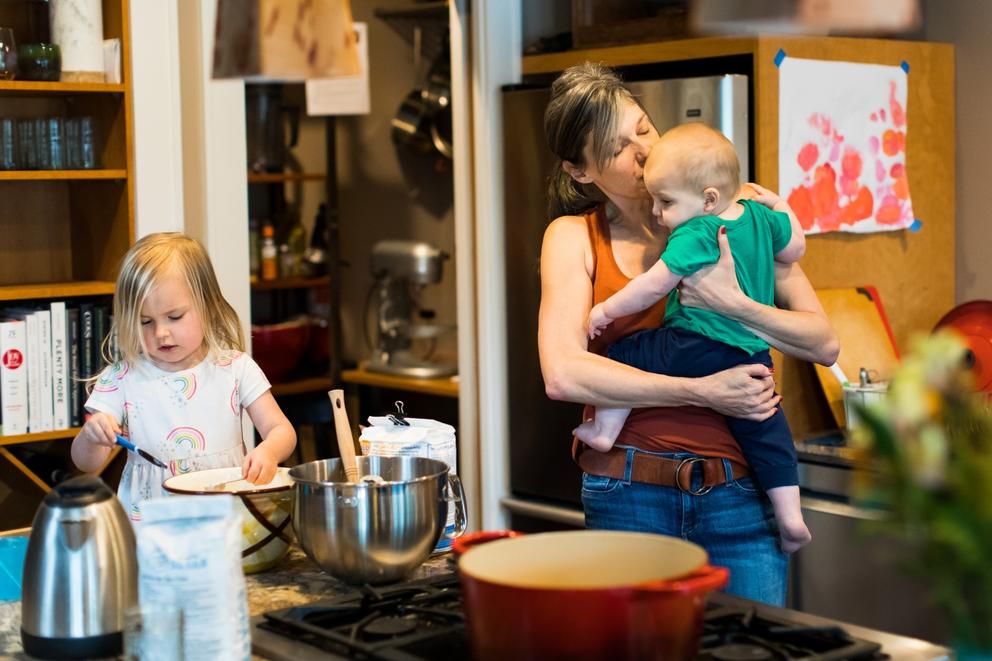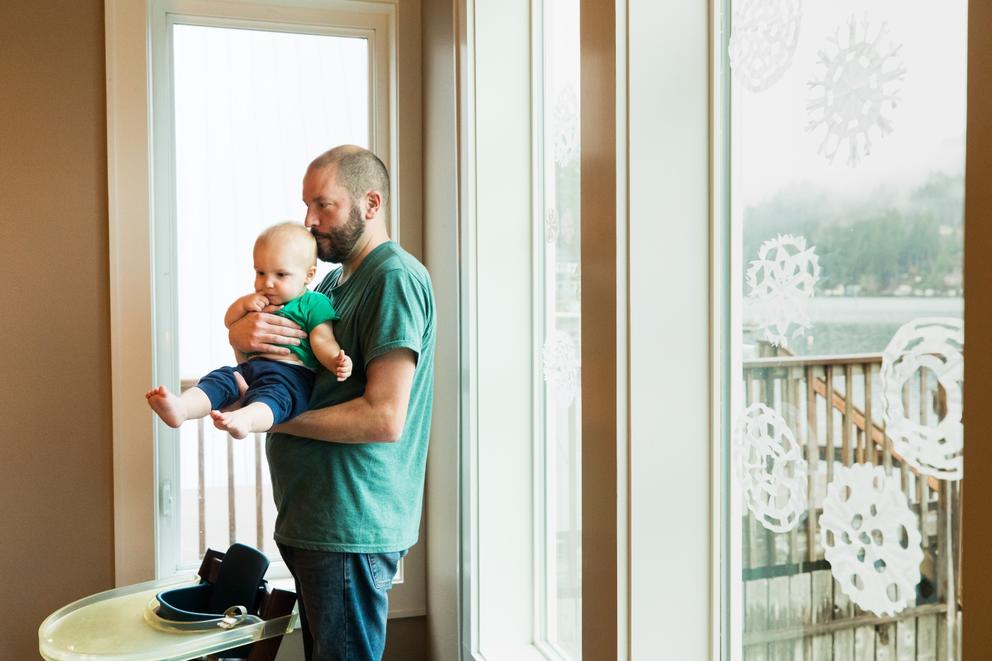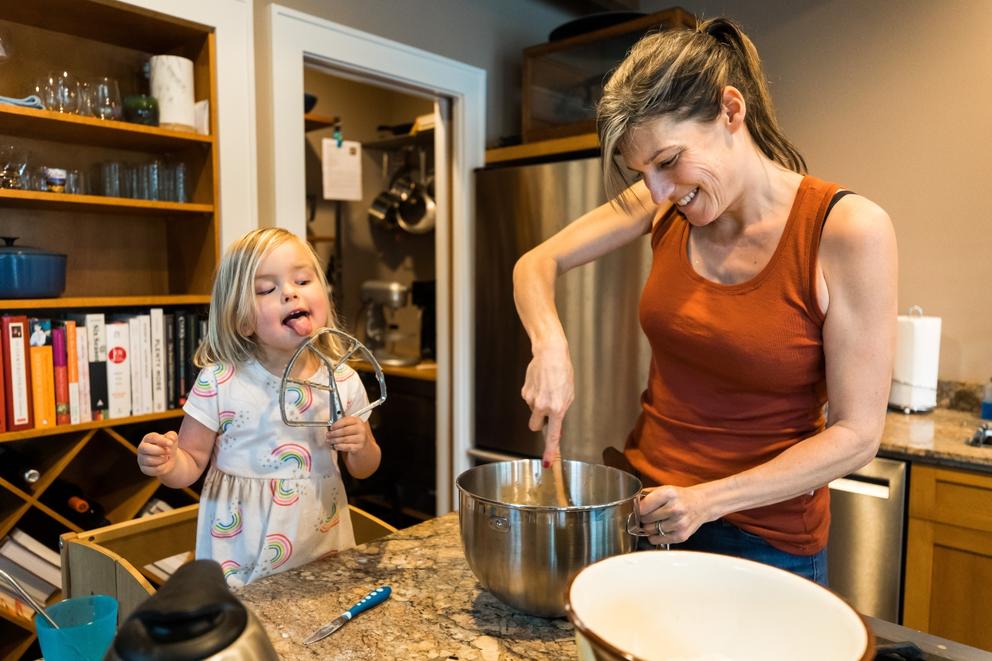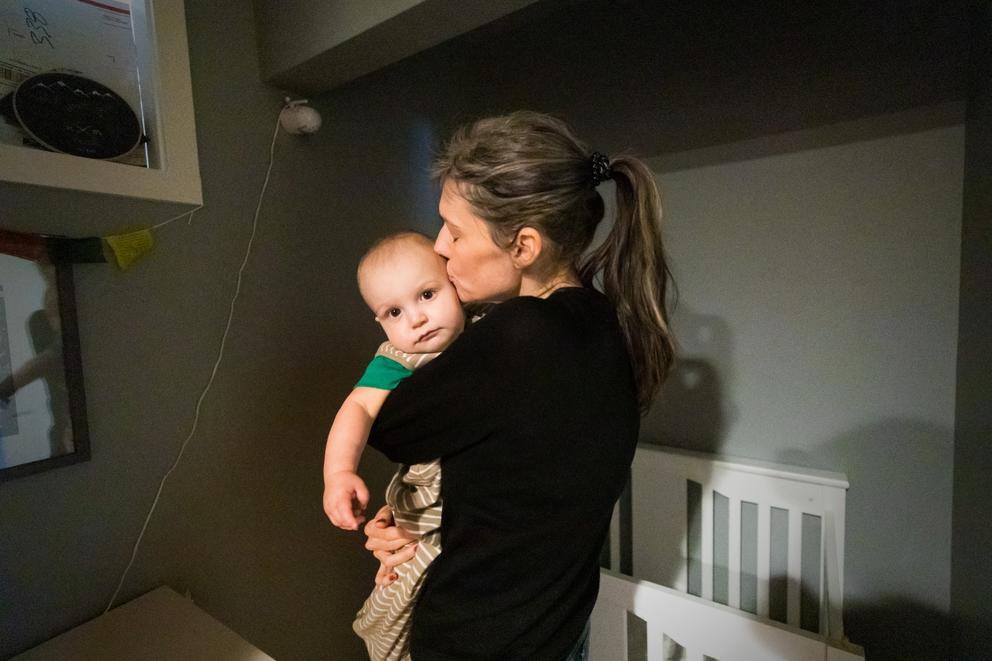That ideology assumes that child care is a private family matter — and thus privately funded. The result of that stance deeply affects the economic opportunities available to women and the care available for their children. It turns out, for instance, that the gender pay gap in this country is largely a motherhood pay gap.
The clashes go beyond questions of motherhood and women’s equality with men. A society that cares about keeping mothers with their young children would seem likely to support paid parental leave. But opinions about child care, and about which mothers can and should stay home with children, are affected by the racism that has plagued this country for its whole existence.
InvestigateWest is a Seattle-based nonprofit newsroom producing journalism for the common good. Learn more and sign up to receive alerts about future stories at http://www.invw.org/newsletters/.
Fatima Goss Graves, president and CEO of the National Women’s Law Center, wrote recently that the devaluation of child care workers connects back to slave women caring for white children — for free, of course. The United States, unlike peer countries, has no nationwide paid parental leave policy and provides limited access to subsidized child care.
The policy differences play out starkly in the lives of women and families.
Parenting, paid work in Finland
Anu Partanen’s 4-year-old daughter attends a highly subsidized Finnish day care while both parents work full-time. The little girl was born in the United States, but in 2018 Partanen, a Finnish and U.S. citizen, and her husband moved back to Helsinki from New York. A journalist famous for her book The Nordic Theory of Everything, she now works as a senior adviser at a consulting firm.
Partanen and her husband weren’t able to enjoy generous parental leave in Finland because their daughter was born in the U.S. But the leave program is a critical piece in Finland’s efforts to support children’s development and foster bonding with both parents. For example, the World Health Organization recommends breast-feeding exclusively for the first six months of a baby’s life. That’s a challenging feat in this country, where moms typically run out of paid leave time well short of that. It is much more workable under the Finnish approach.
Partanen said family life in Finland is much less stressful and far more affordable than in the U.S. In Finland, mothers aren’t forced to choose between parenting and paid work, so a higher percentage of them are employed. As Partanen put it, businesses and individuals pay taxes to a government for services, like health care, that they expect to use themselves and thus expect it to be high quality. Government services aren’t just for low-income families. And mothers of infants don’t have to depend on their partners for income or health insurance.
The Finnish system might be viewed in this country as radically socialist, big-government overstepping. But Finland's is a capitalist system, with higher social mobility than the United States, supporting children to fulfill their potential. In Finland, as in all Nordic countries, a child is more likely than their U.S. counterpart to “experience a better life” than their parents.
In the U.S., unlike in Finland, there is no federal paid parental leave, no broad support for access to full-time, affordable, quality child care, no universal health care and no free college education.
“In the Nordic countries, there is more of the thinking that a child has rights independent of their parents, and it’s the society’s and the laws’ duty to give children those opportunities and those rights, regardless of their parents,” Partanen explained.
Falling behind in the United States
Like Partanen, Meaghan Mounger has a preschool daughter. The difference? Mounger feels acutely the burdens of the high price of child care, limited paid parental leave and precarious work that force difficult tradeoffs. She is a full-time mother of two, living outside Olympia, who wanted to have her infant children at home with a parent.
In 2017, Mounger was 39 and just a year into a career shift to information technology at the Washington State Department of Ecology. The job made good use of her bachelor’s degree in environmental science (she also has a B.A. in literature) and her certificate in geographic information systems, widely used in industry and government to map and analyze data.
It was a time of change for her. In the past, she had often worked two jobs to pay the bills and save some money. Then in 2017, she married another environmental scientist, Kyle Graunke, who shares custody of two school-age sons from a previous marriage. In September 2017, Mounger was seven months pregnant with their first child when her temporary job disappeared due to funding cuts in her department.
It seemed to make little sense to look for another job right away, knowing that she would have to take maternity leave only a few weeks later. Once the baby arrived, the price of infant child care meant that going back to work also didn’t make sense, this time financially. But she was also grateful to have time with her baby.
“To have the opportunity to be home with my daughter felt like a huge gift,” she said.
Three years later, their son came along. Mounger also feels grateful to be able to stay home with him for his first year, but she’s thinking about how to get back to her career. The openings she has found involve long commutes, a paycheck that would barely cover child care expenses and little time left for her kids.
If she waits to return to paid work until both kids are in school, she figures her career might never rebound. In her ideal world, both she and her husband could work quality part-time jobs, be at home part time and even afford part-time preschool for their daughter.
“I’ve put myself in a position that I never thought I would be in, as a woman,” she said. “I’m dependent on my husband.” She had expected to earn as much as or more than him eventually. Instead, like other full-time moms, she worries about their financial situation if something were to happen to her husband or to his job and its benefits.
Consensus and divergence
While some political and cultural divisions in this country seem to be growing, there is also increasing support — if not consensus — for major changes in this country’s child care policies that would be funded by major government investments.
In a recent national poll, well over half of American voters said they are willing to tax themselves to fund such programs and services for children.
The child care and universal preschool provisions in the federal Build Back Better legislation are a step toward significantly changing the calculations Mounger is making about paid work and child care.
In Washington state, many legislators, business leaders, parents, care providers and advocacy groups agree that a much better system is needed to help children now, give them better futures, help parents support their families and boost the state economy. And they largely agree that such a system should support diverse choices for parents.
But they don’t agree on who should manage and pay for it.
Washington’s Fair Start for Kids Act passed the state Senate with no Republican support and passed the House with eight of 41 Republicans supporting it. Debate on the Senate floor and in committee hearings was dominated by talk about the size of government and burdensome regulations.
State Rep. Bob McCaslin, a Spokane Valley Republican who is a former kindergarten teacher and former member of the state’s Child Care Collaborative Task Force, is concerned that some changes in the Fair Start legislation represent too much government and a one-size-fits-all approach. He said the overseeing agency, the state Department of Children, Youth and Families, has a poor fiscal track record and has promoted far too expensive programs, some of which the private sector could do for much less money.
But state legislators’ stances on expanded child care programs are complicated by the main device for funding Fair Start for Kids: a controversial capital gains tax. Opponents like the Washington Policy Center, a conversative think tank, see it as unconstitutional and a gateway to a state income tax. Some legislators said it is too volatile, that the revenue to the state would swing too widely. Supporters of the tax, of course, disputed those arguments and have won for now.
Some people are concerned that President Joe Biden’s Build Back Better program, like other large public programs, could reduce the role of parents (read: moms) and intrude on the private family.
So, while some advocates say recent major changes aren’t enough, a fundamentally different system, one more like in Finland, also feels out of reach. That type of system is built on broadly agreed-upon core values of gender equality and investment in children as a social good, like public schools, that needs to be funded by all citizens rather than just by parents.
Another difference: The United States has a diverse population and a history of racist policies and practices. That led some supporters of Fair Start for Kids to focus heavily on what the program would do to advance racial equity.
Recently retired Washington state Rep. Ruth Kagi remains an active member of the Child Care Collaborative Task Force, co-chairs the Children’s Campaign Fund and has recently co-authored a report on universal preschool in Washington state. She also helps care for her grandchildren.
Kagi said that in Washington state, one key factor shifted the conversation in the Legislature about 12 years ago: research that showed how critical early bonding with a responsive adult is to brain development in infants and how that, together with early childhood development, ties directly to school readiness and success. Those findings helped build Democratic and even some bipartisan agreement on investing in young children.
That coalition now seems less secure.
But maybe one part of Nordic societies’ system is doable here: finding ways to allow parents to stay home longer with their babies. Parental leave seems to resonate with Americans across political and cultural divides.
Many U.S. parents want to stay with their infants for longer than is usually possible under current conditions. Paid leave is very popular in public opinion polls, and in Washington state many employed parents can now access paid family and medical leave of 12 weeks per parent. Kagi called 12 weeks “absolutely the minimum” for families.
Only 10 states have paid family and medical leave laws. Washington’s requirement of 12 weeks for new parents is one of the higher ones. Oregon passed its own 12-week paid family-leave law but has delayed rollout of the new benefits until September 2023.
Kagi said that “obviously Finland is the model” here but, given that it’s such a challenge to get even a month of leave included in federal legislation, she is not optimistic about expanding beyond that. Although they like the general idea, Americans differ on whether paid leave should be mandated and who should pay for it.
Because it would greatly reduce the number of parents needing infant care, expanded parental leave could also alleviate the shortage of such care and reduce its through-the-roof prices.
Gender, family, race and cultural divides
Even though the lowest-income and furthest-from-opportunity families can access child care subsidies and some free preschool, there are not enough slots, especially full-time preschool slots, to allow low-income parents to work full-time.
So, in a flip from earlier decades, the high price of child care keeps working-class parents at home caring for kids. It is now the upper- and upper-middle-class women and families who can afford (even if barely) full-time child care while both parents work.
Polls show that 60% of Americans think that a child is better off with a parent, usually a mother, at home. But in practice, policies reflect that opinion only when the mom is married, with at least a working-class income. If a parent is poor or single or both, the feeling seems to be they should get back to paid work, get married or find that elusive better job. And who is more likely to be a low-income single parent? Latina, Native American and Black women.
In the United States, research has backed up the reality that activists and politicians already see playing out: that many people here view poor people as lazy rather than just unfortunate. And race plays a role in those assumptions. People who see anti-poverty programs as income redistribution also figure their tax dollars are going to disproportionately help people of color.
A prime example is the federal welfare program, Temporary Assistance for Needy Families, or TANF. President Bill Clinton signed it into law, placing a 60-month lifetime limit on cash assistance and imposing significant work and job-readiness requirements for recipients. The program is called “WorkFirst” in Washington state. Parents of children under 2 years old can take advantage of work participation exemptions for up to 24 months.
TANF is a lifeline for low-income families, but it has limitations that reflect the biases in American society, said Marcy Bowers, executive director of the Washington-based Statewide Poverty Action Network.
“The creation of TANF was tied to the myth of the Black welfare queen,” she said. “That myth permeates the program today. It permeates how people think about TANF or other welfare-type programs. … I wish I could say that was not the conversation that we are having, that we are strictly talking about the data and the research, but that’s just not what humans do.”
No matter how strong or weak the public safety net is, including child care, it functions better for many white families because they have, on average, much less drastic and urgent needs compared with Black and Native American families, said Jennie Romich, professor at the University of Washington School of Social Work. Historically, policies promoted white wealth while denying the same to Black and Native American families; those same families had labor and land stolen from them.
So when the primary safety net in the United States is private families and intergenerational wealth, a white single mother is more likely to have family who can help by providing a home, care of kids or money to pay for child care.
Judged on all sides
Another set of contradictory messages that get in the way of child care reform involve motherhood itself. Mainstream American culture has been telling women for years they can have it all and do it all — be ambitious in their careers and also devoted to the weighty tasks of raising children, without significantly higher expectations of fathers’ involvement and without changes in workplaces and policies.
But mothers are still held primarily responsible for children’s health and well-being. They feel judged on all sides: for staying home, for doing full-time paid work and even for dialing back their careers for a while instead of “leaning in.”
These contradictory messages are reflected in motherhood penalties in the workplace. When American moms try to reenter the paid workforce, they face discrimination based on their absence from paid work and possibly rusty skills. This after they’ve put in work that, if valued at minimum wage, was worth $1.5 trillion in 2019.
According to multiple analyses, women who take time off to parent full-time or even part-time pay the price of the “mommy track:” less career mobility, lower pay and thus lower lifetime earnings. Meaghan Mounger isn’t wrong to worry about her career future.
Risman, with the Council on Contemporary Families, which is a nonprofit organization that provides the media and public with the latest research about American families, of the University of Illinois Chicago argued that both mothers and fathers are struggling to “be very valuable employees” in workplaces that are still “designed with the presumption that workers have wives.” Dual-earner families with traditional 9-to-5 jobs (or more realistically 8-to-6), let alone single-parent families, can’t possibly take care of everything from preparing dinner to helping kids with homework to even caring for elder parents.
Even without better child care options, more flexible jobs could make a real difference for some parents. Numerous companies, from call centers to consulting firms, were experimenting with this even before the pandemic: focusing on work productivity and goals rather than hours spent in the office.
Risman is optimistic that the pandemic could bring some lasting changes to the private sector, so that people like Mounger and her husband can fit together paid work and parenting, ideally in ways that don’t permanently penalize either of them.
“Call me a Pollyanna, but I think we are at this moment where we could have really radical readjustments,” she said. Because the COVID-19 pandemic presented “such a shock to the system,” she said, “the incompatibility of the way we’ve organized work and child rearing has been so in our face.
“A lot of companies are no longer requiring full-time in-office work,” which suits a lot of employees, she said, “particularly ones who have children, [who] can work from 6 to 9 a.m., can take the kids out for a walk, at 3 pick up kids after school, take them to a dance class and then go back to work for three hours. It gives parents all sorts of flexibility.”
Risman said the United States is “at a moment where we could really redesign American society so that it is compatible with work and caregiving … with the principle of gender equality front and center.”
But that kind of predictable flexibility doesn’t usually work for waitstaff or retail clerks or any of the other service industries dominated by women and especially women of color, where telecommuting is not an option. This is where public policy is needed. Risman called universal preschool and subsidized child care a “game changer” for these parents.
Kagi agreed that the pandemic has had a silver lining in forcing society and particularly employers to take a new look at child care and realize it isn’t just the mom’s problem to figure out.
In Washington, the foundation for a child care system that is accessible and affordable for more families already exists, she said: “We’ve got a high-quality child care program and a high-quality pre-K program. We just haven’t put the resources in.”
Caroline Guzman contributed to this report.







